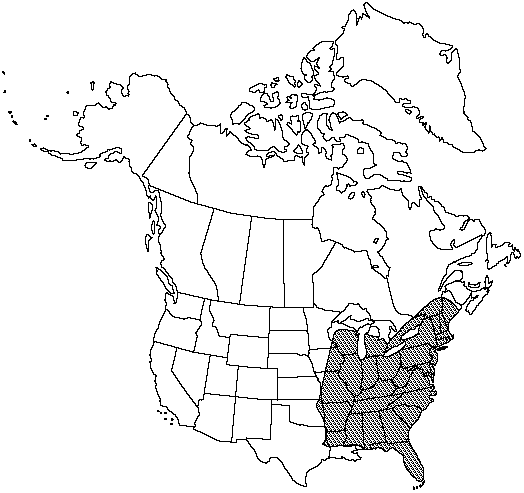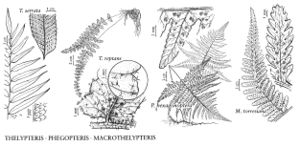Difference between revisions of "Phegopteris hexagonoptera"
5: 242. 1852.
FNA>Volume Importer |
imported>Volume Importer |
||
| (7 intermediate revisions by 2 users not shown) | |||
| Line 7: | Line 7: | ||
}} | }} | ||
|common_names=Broad beech fern;southern beech fern;phégoptère à hexagones | |common_names=Broad beech fern;southern beech fern;phégoptère à hexagones | ||
| − | |basionyms={{Treatment/ID/ | + | |special_status={{Treatment/ID/Special_status |
| + | |code=F | ||
| + | |label=Illustrated | ||
| + | }}{{Treatment/ID/Special_status | ||
| + | |code=E | ||
| + | |label=Endemic | ||
| + | }} | ||
| + | |basionyms={{Treatment/ID/Basionym | ||
|name=Polypodium hexagonopterum | |name=Polypodium hexagonopterum | ||
|authority=Michaux | |authority=Michaux | ||
| + | |rank=species | ||
| + | |publication_title=Fl. Bor.-Amer. | ||
| + | |publication_place=2: 271. 1803 | ||
}} | }} | ||
|synonyms={{Treatment/ID/Synonym | |synonyms={{Treatment/ID/Synonym | ||
|name=Dryopteris hexagonoptera | |name=Dryopteris hexagonoptera | ||
|authority=(Michaux) C. Christensen | |authority=(Michaux) C. Christensen | ||
| − | }}{{Treatment/ID/Synonym | + | |rank=species |
| + | }} {{Treatment/ID/Synonym | ||
|name=Thelypteris hexagonoptera | |name=Thelypteris hexagonoptera | ||
|authority=(Michaux) Nieuwland | |authority=(Michaux) Nieuwland | ||
| + | |rank=species | ||
}} | }} | ||
|hierarchy=Thelypteridaceae;Phegopteris;Phegopteris hexagonoptera | |hierarchy=Thelypteridaceae;Phegopteris;Phegopteris hexagonoptera | ||
| Line 25: | Line 37: | ||
}}<!-- | }}<!-- | ||
| − | --><span class="statement" id="st- | + | --><span class="statement" id="st-undefined" data-properties=""><b>Stems </b>long-creeping, 2–4 mm diam. <b>Leaves</b> monomorphic, dying back in winter, often 1–2 cm apart, ca. 25–75 cm. <b>Petiole</b> straw-colored, (7–)20–45 cm × 1.5–3 mm, at base with scales tan, lanceolate, glabrous or marginally hairy. <b>Blade</b> broadly deltate, about as broad as long, (8–)15–33 cm, proximal pinnae longest and narrowed at base, usually spreading or slightly ascending. <b>Pinnae</b> 7–20 × 2–6(–8) cm, all connected by wing along rachis, deeply pinnatifid; segments entire or largest pinnatifid about halfway to costule; proximal pair of veins from adjacent segments meeting margin above sinus, veins often forked. <b>Indument</b> abaxially of moderately to densely set hairs mostly 0.1–0.25 mm along costae and veins, also of yellowish stalked glands 0.1 mm on veins and blade tissue, costae with whitish to light tan, narrowly lanceolate, spreading, marginally hairy scales to ca. 1.5 mm. <b>Sori</b> subterminal on veins. <b>2n</b> = 60.</span><!-- |
-->{{Treatment/Body | -->{{Treatment/Body | ||
| Line 31: | Line 43: | ||
|elevation=0–1000 m | |elevation=0–1000 m | ||
|distribution=Ont.;Que.;Ala.;Ark.;Conn.;Del.;D.C.;Fla.;Ga.;Ill.;Ind.;Iowa;Kans.;Ky.;La.;Maine;Md.;Mass.;Mich.;Minn.;Miss.;Mo.;N.H.;N.J.;N.Y.;N.C.;Ohio;Okla.;Pa.;R.I.;S.C.;Tenn.;Tex.;Vt.;Va.;W.Va.;Wis. | |distribution=Ont.;Que.;Ala.;Ark.;Conn.;Del.;D.C.;Fla.;Ga.;Ill.;Ind.;Iowa;Kans.;Ky.;La.;Maine;Md.;Mass.;Mich.;Minn.;Miss.;Mo.;N.H.;N.J.;N.Y.;N.C.;Ohio;Okla.;Pa.;R.I.;S.C.;Tenn.;Tex.;Vt.;Va.;W.Va.;Wis. | ||
| − | |discussion=<p>G. A. Mulligan and W. J. Cody (1979) reported hybrids between Phegopteris hexagonoptera and P. connectilis from a few localities in Quebec, New Brunswick, and Nova Scotia. These hybrids are apogamous and have a chromosome number of 2n = 120.</p> | + | |discussion=<p>G. A. Mulligan and W. J. Cody (1979) reported hybrids between <i>Phegopteris hexagonoptera</i> and <i>P. connectilis</i> from a few localities in Quebec, New Brunswick, and Nova Scotia. These hybrids are apogamous and have a chromosome number of 2n = 120.</p> |
|tables= | |tables= | ||
|references= | |references= | ||
| Line 40: | Line 52: | ||
-->{{#Taxon: | -->{{#Taxon: | ||
name=Phegopteris hexagonoptera | name=Phegopteris hexagonoptera | ||
| − | |||
|authority=(Michaux) Fée | |authority=(Michaux) Fée | ||
|rank=species | |rank=species | ||
| Line 53: | Line 64: | ||
|publication title= | |publication title= | ||
|publication year=1852 | |publication year=1852 | ||
| − | |special status= | + | |special status=Illustrated;Endemic |
| − | |source xml=https:// | + | |source xml=https://bitbucket.org/aafc-mbb/fna-data-curation/src/2e0870ddd59836b60bcf96646a41e87ea5a5943a/coarse_grained_fna_xml/V2/V2_95.xml |
|genus=Phegopteris | |genus=Phegopteris | ||
|species=Phegopteris hexagonoptera | |species=Phegopteris hexagonoptera | ||
| − | |||
| − | |||
| − | |||
| − | |||
| − | |||
| − | |||
| − | |||
| − | |||
| − | |||
| − | |||
| − | |||
| − | |||
| − | |||
| − | |||
| − | |||
| − | |||
| − | |||
| − | |||
| − | |||
| − | |||
| − | |||
| − | |||
| − | |||
| − | |||
| − | |||
| − | |||
| − | |||
| − | |||
| − | |||
| − | |||
| − | |||
| − | |||
| − | |||
| − | |||
| − | |||
| − | |||
| − | |||
}}<!-- | }}<!-- | ||
-->[[Category:Treatment]][[Category:Phegopteris]] | -->[[Category:Treatment]][[Category:Phegopteris]] | ||
Latest revision as of 20:25, 5 November 2020
Stems long-creeping, 2–4 mm diam. Leaves monomorphic, dying back in winter, often 1–2 cm apart, ca. 25–75 cm. Petiole straw-colored, (7–)20–45 cm × 1.5–3 mm, at base with scales tan, lanceolate, glabrous or marginally hairy. Blade broadly deltate, about as broad as long, (8–)15–33 cm, proximal pinnae longest and narrowed at base, usually spreading or slightly ascending. Pinnae 7–20 × 2–6(–8) cm, all connected by wing along rachis, deeply pinnatifid; segments entire or largest pinnatifid about halfway to costule; proximal pair of veins from adjacent segments meeting margin above sinus, veins often forked. Indument abaxially of moderately to densely set hairs mostly 0.1–0.25 mm along costae and veins, also of yellowish stalked glands 0.1 mm on veins and blade tissue, costae with whitish to light tan, narrowly lanceolate, spreading, marginally hairy scales to ca. 1.5 mm. Sori subterminal on veins. 2n = 60.
Habitat: In moist woods, usually in full shade, often in moderately acid soils
Elevation: 0–1000 m
Distribution

Ont., Que., Ala., Ark., Conn., Del., D.C., Fla., Ga., Ill., Ind., Iowa, Kans., Ky., La., Maine, Md., Mass., Mich., Minn., Miss., Mo., N.H., N.J., N.Y., N.C., Ohio, Okla., Pa., R.I., S.C., Tenn., Tex., Vt., Va., W.Va., Wis.
Discussion
G. A. Mulligan and W. J. Cody (1979) reported hybrids between Phegopteris hexagonoptera and P. connectilis from a few localities in Quebec, New Brunswick, and Nova Scotia. These hybrids are apogamous and have a chromosome number of 2n = 120.
Selected References
None.
